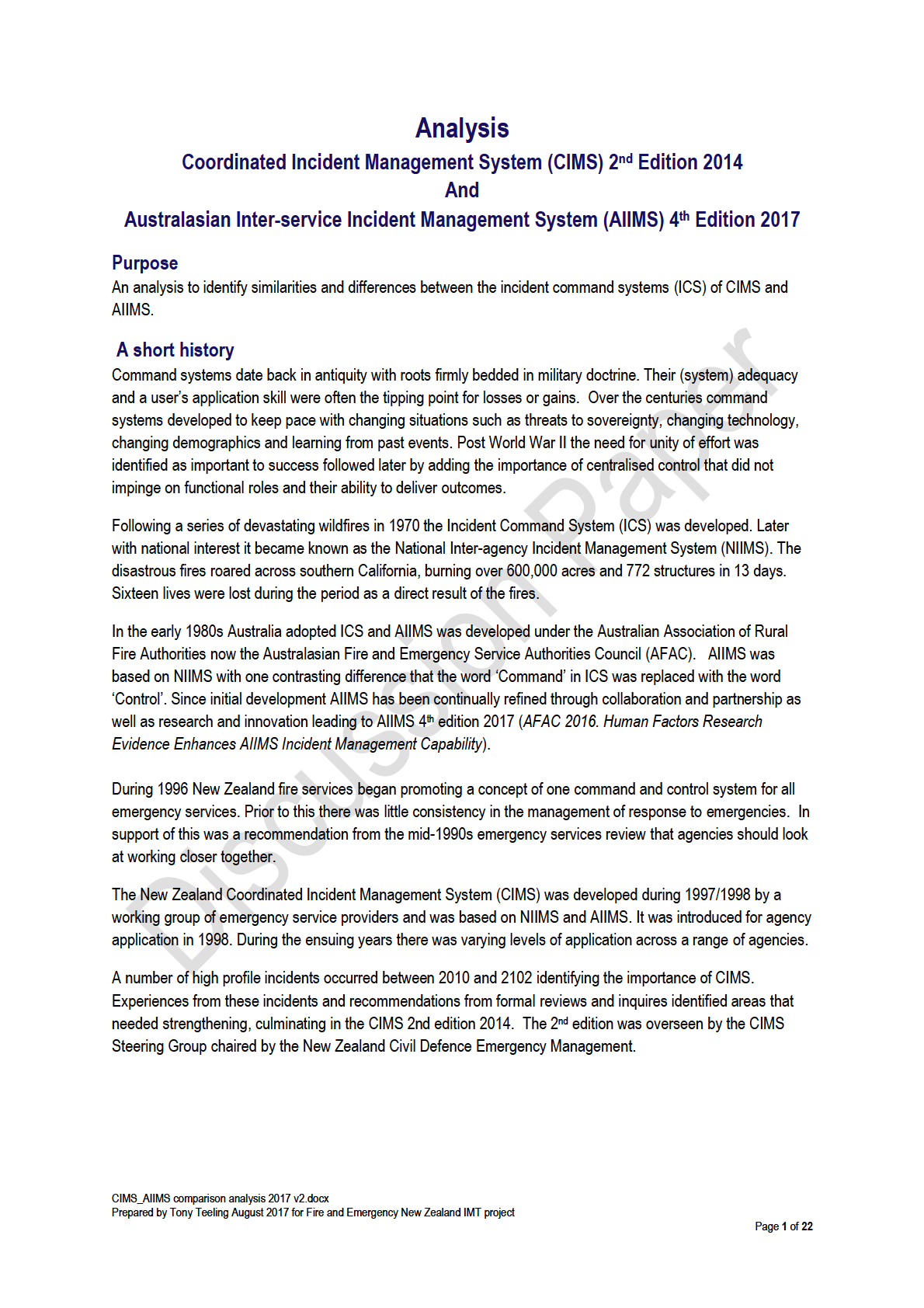
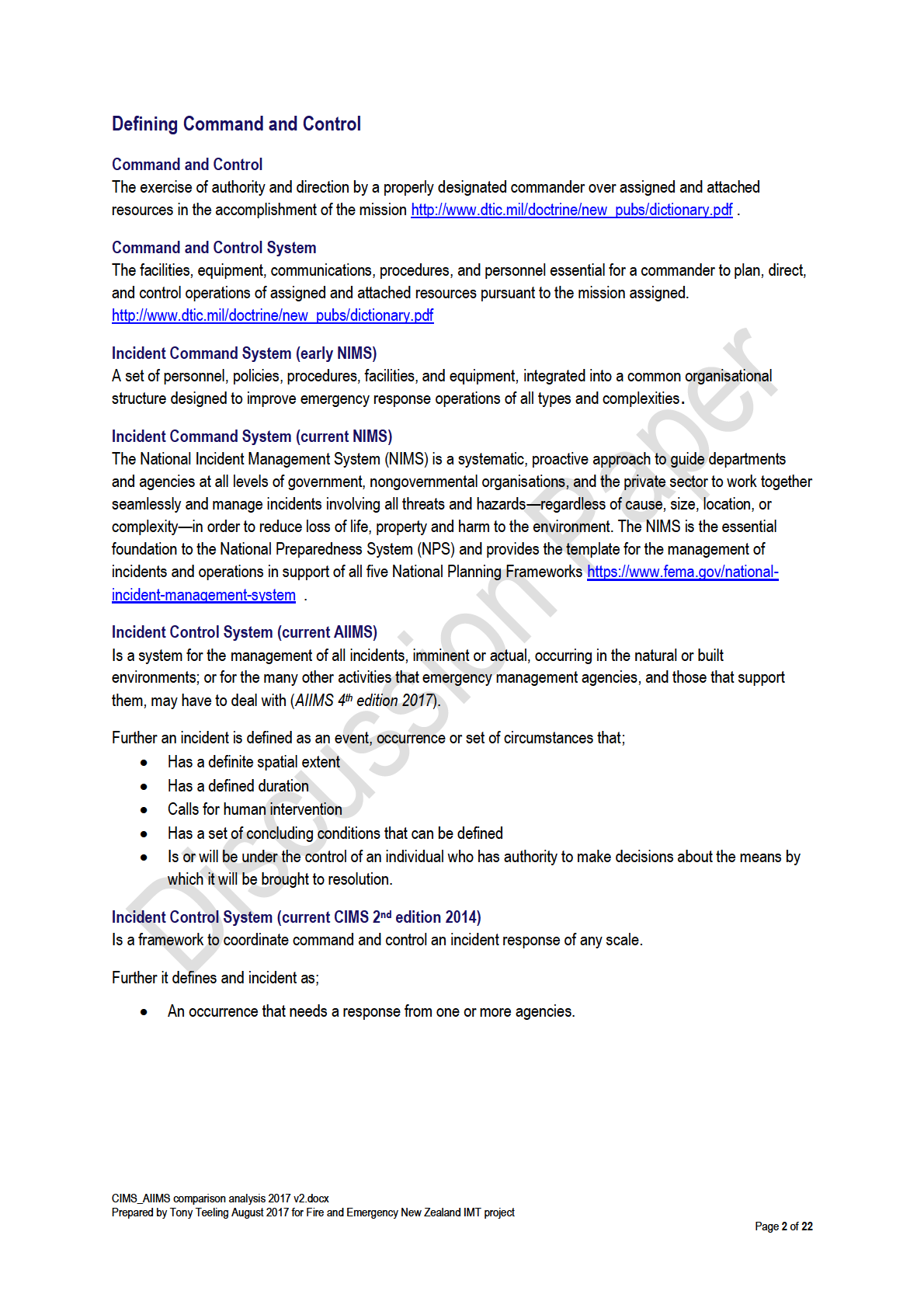

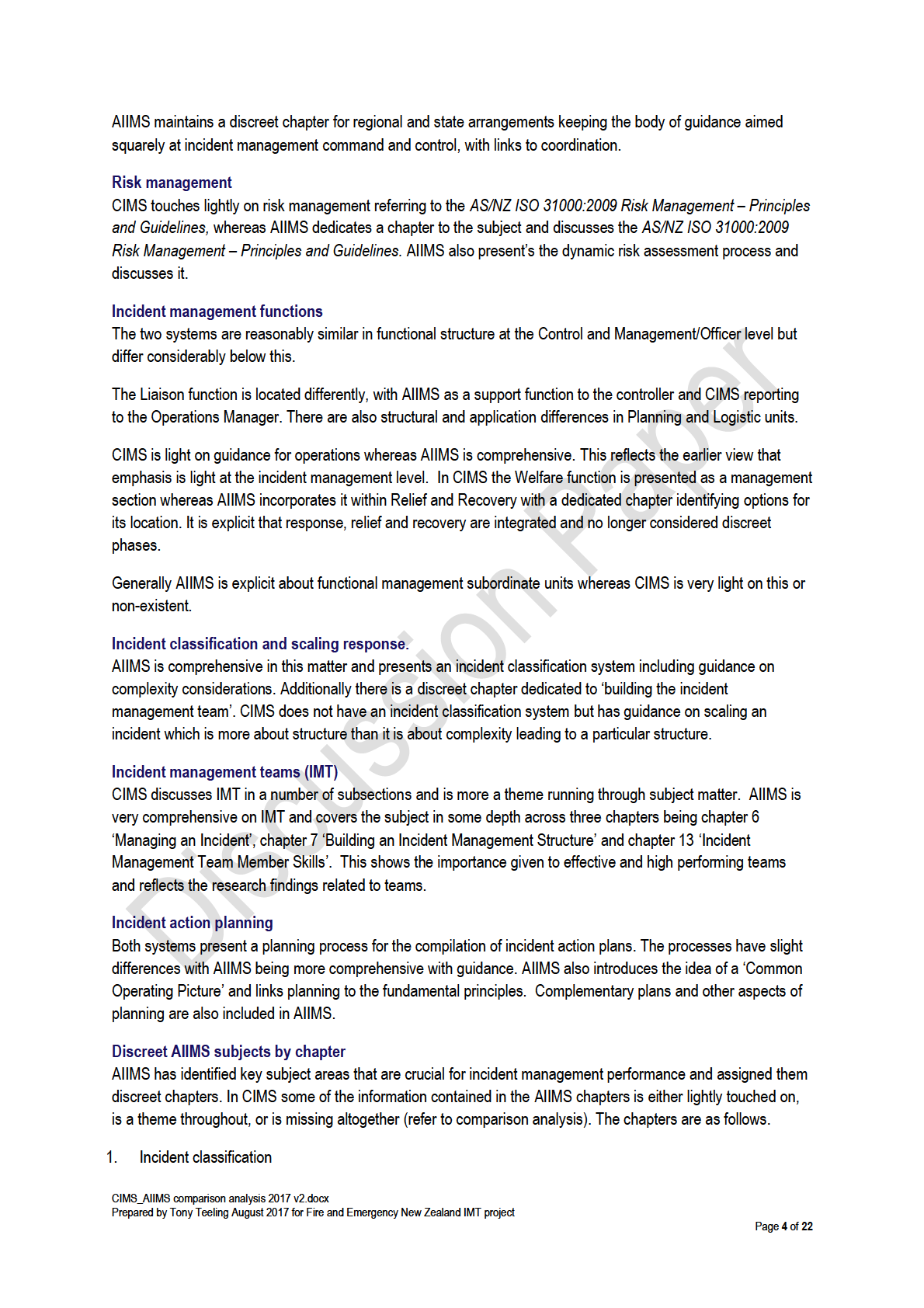

link to page 7 link to page 8 link to page 8 link to page 9 link to page 9 link to page 10 link to page 10 link to page 11 link to page 11 link to page 11 link to page 12 link to page 12 link to page 13 link to page 13 link to page 14 link to page 14 link to page 15 link to page 15 link to page 16 link to page 16 link to page 17 link to page 17 link to page 18 link to page 18 link to page 19 link to page 19 link to page 20 link to page 20 link to page 21 link to page 21 link to page 21
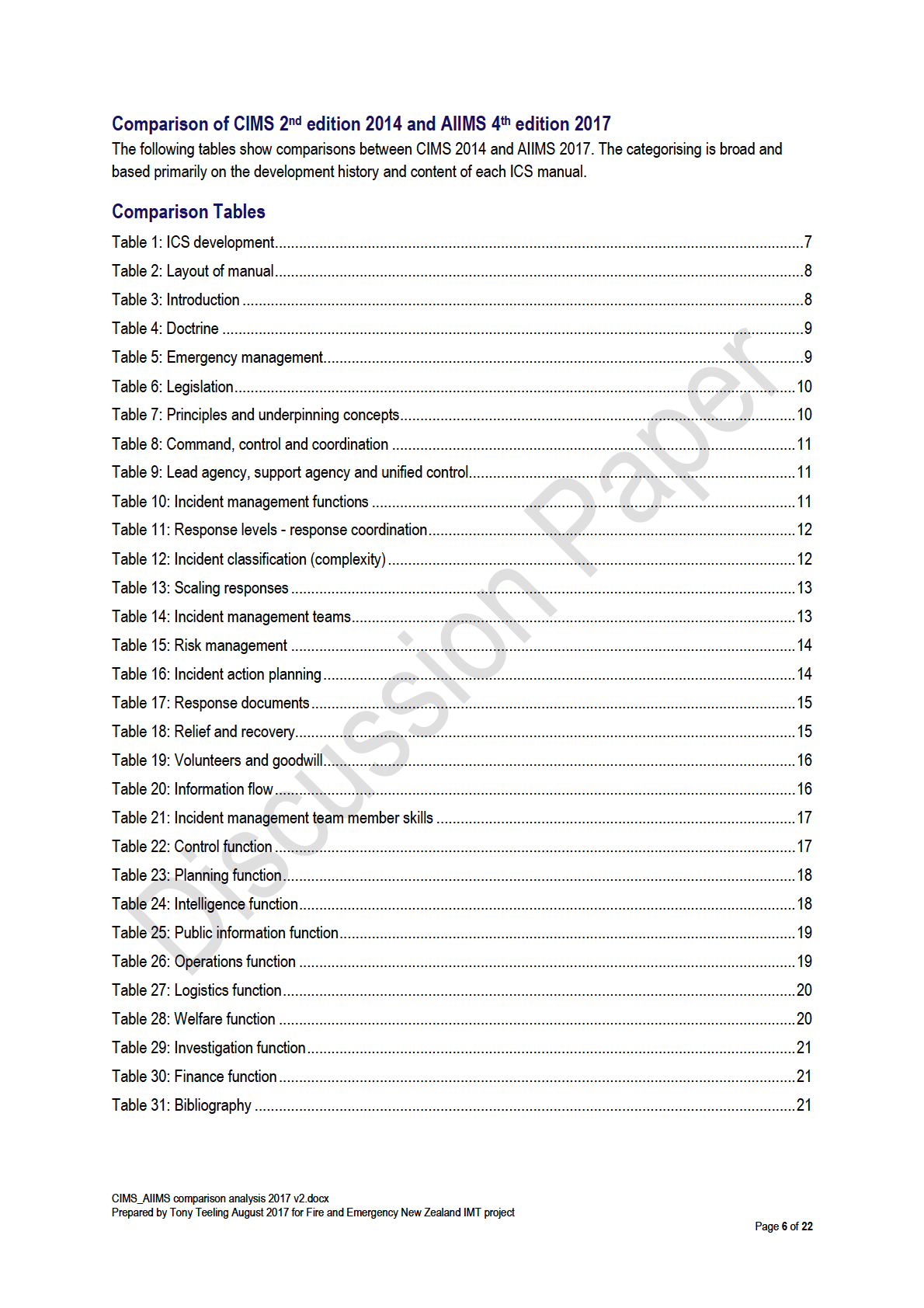


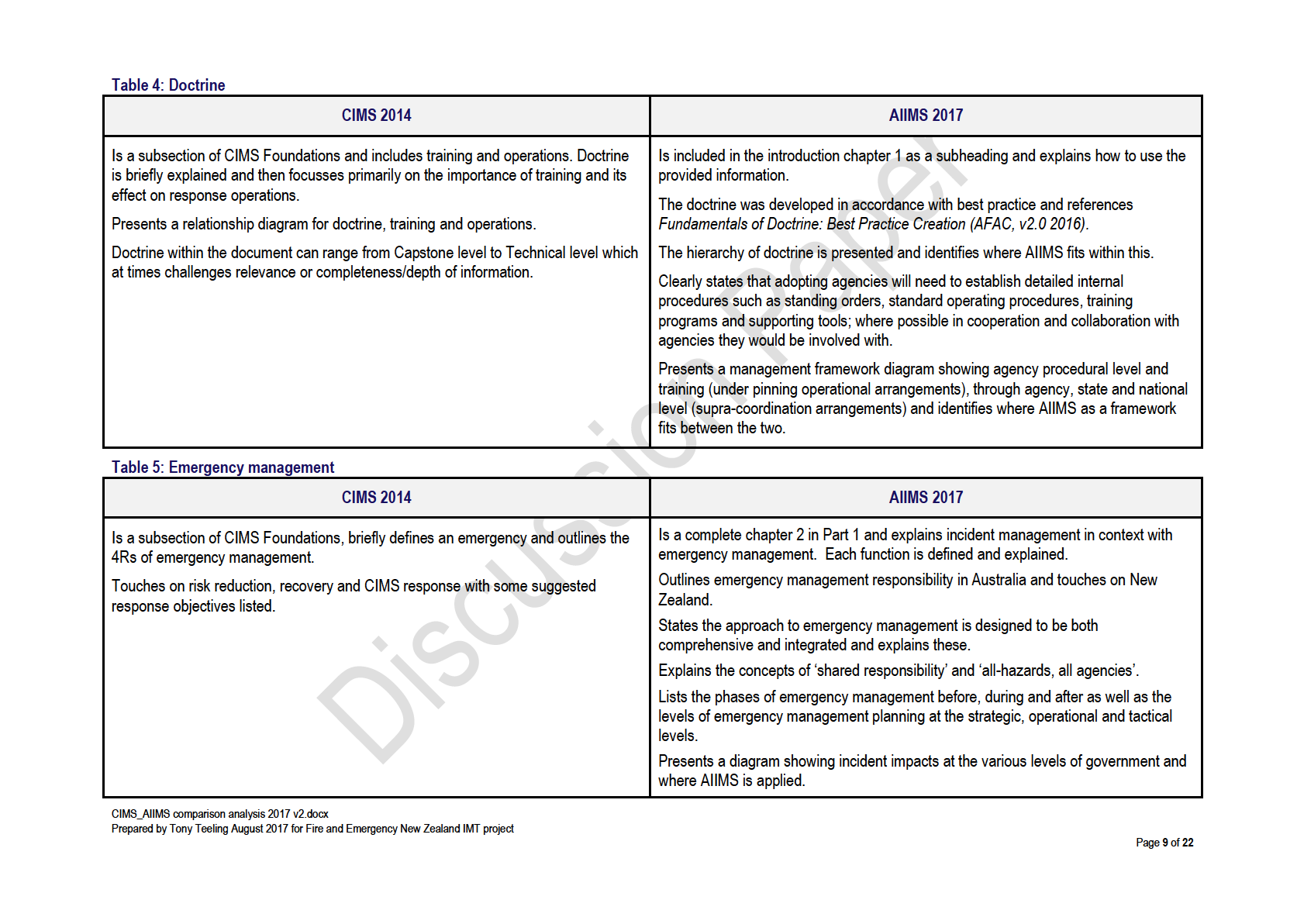
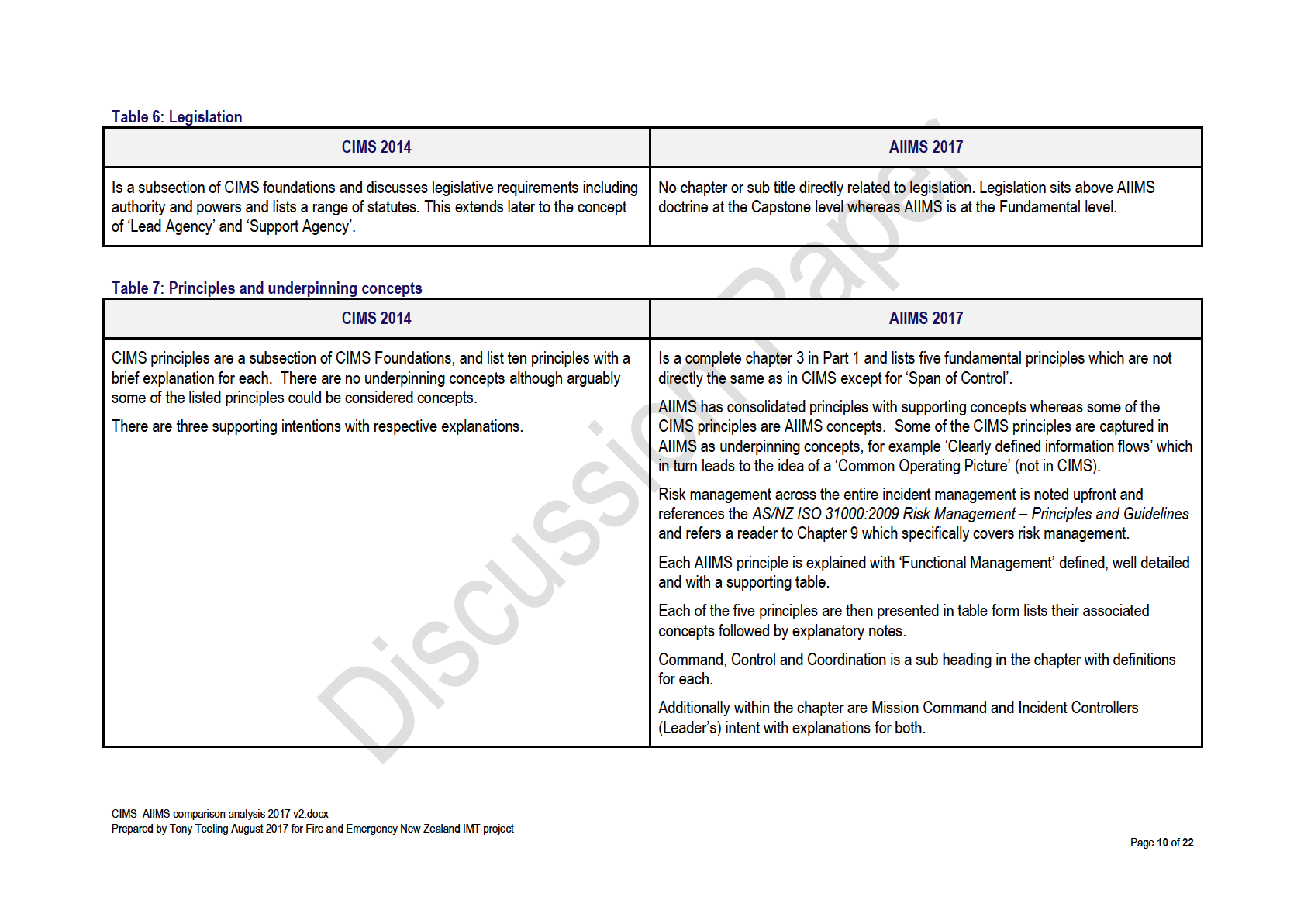
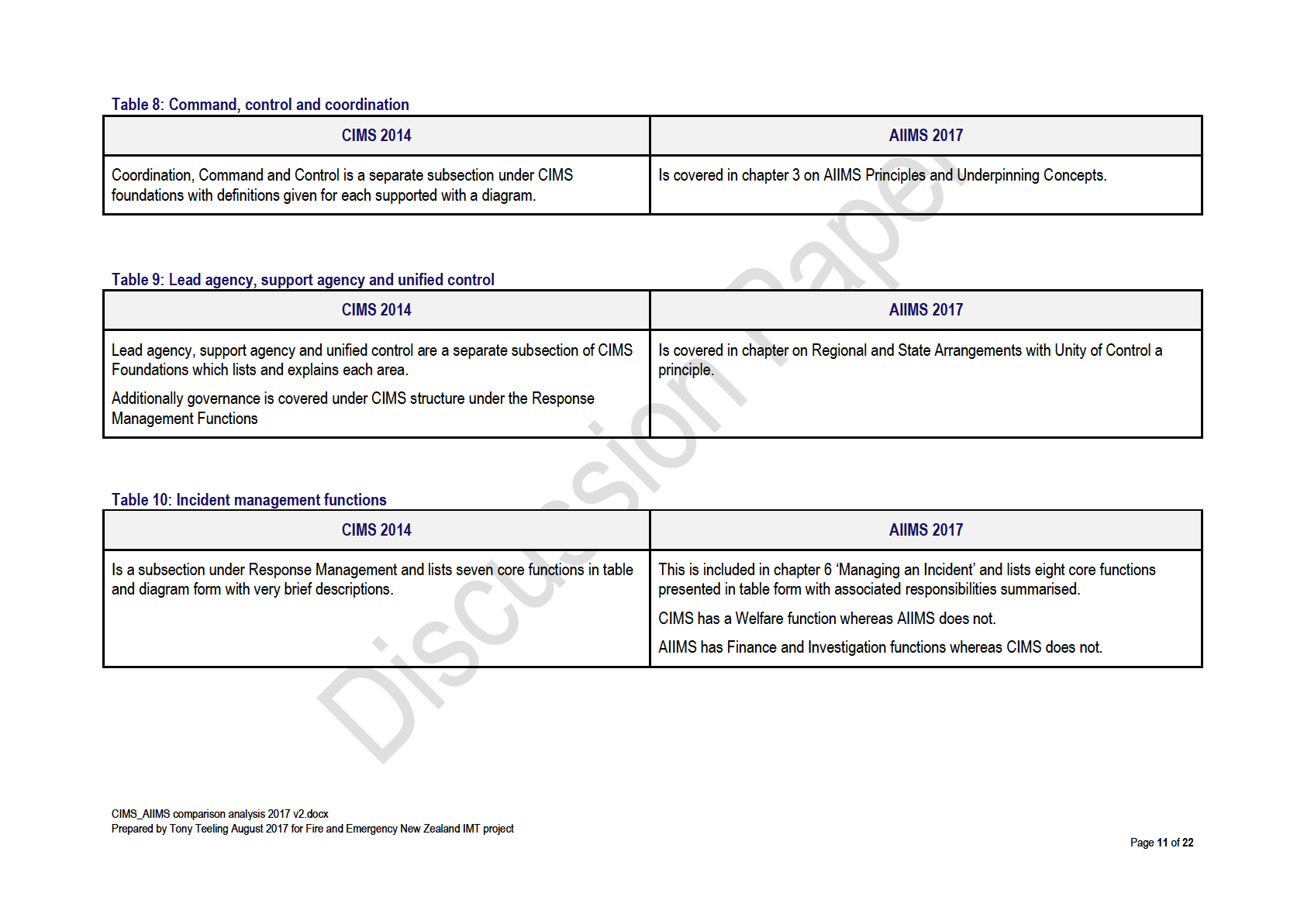

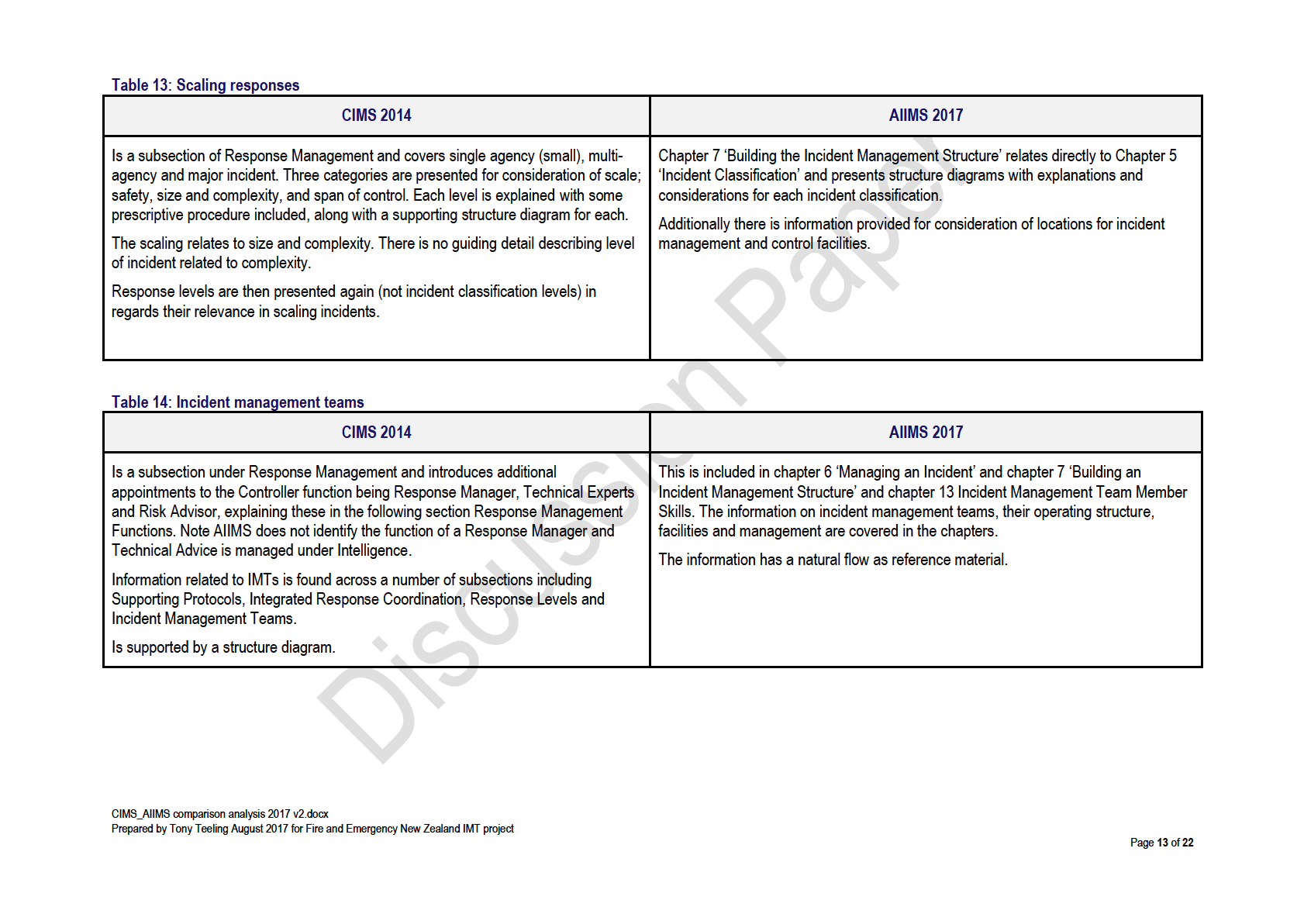
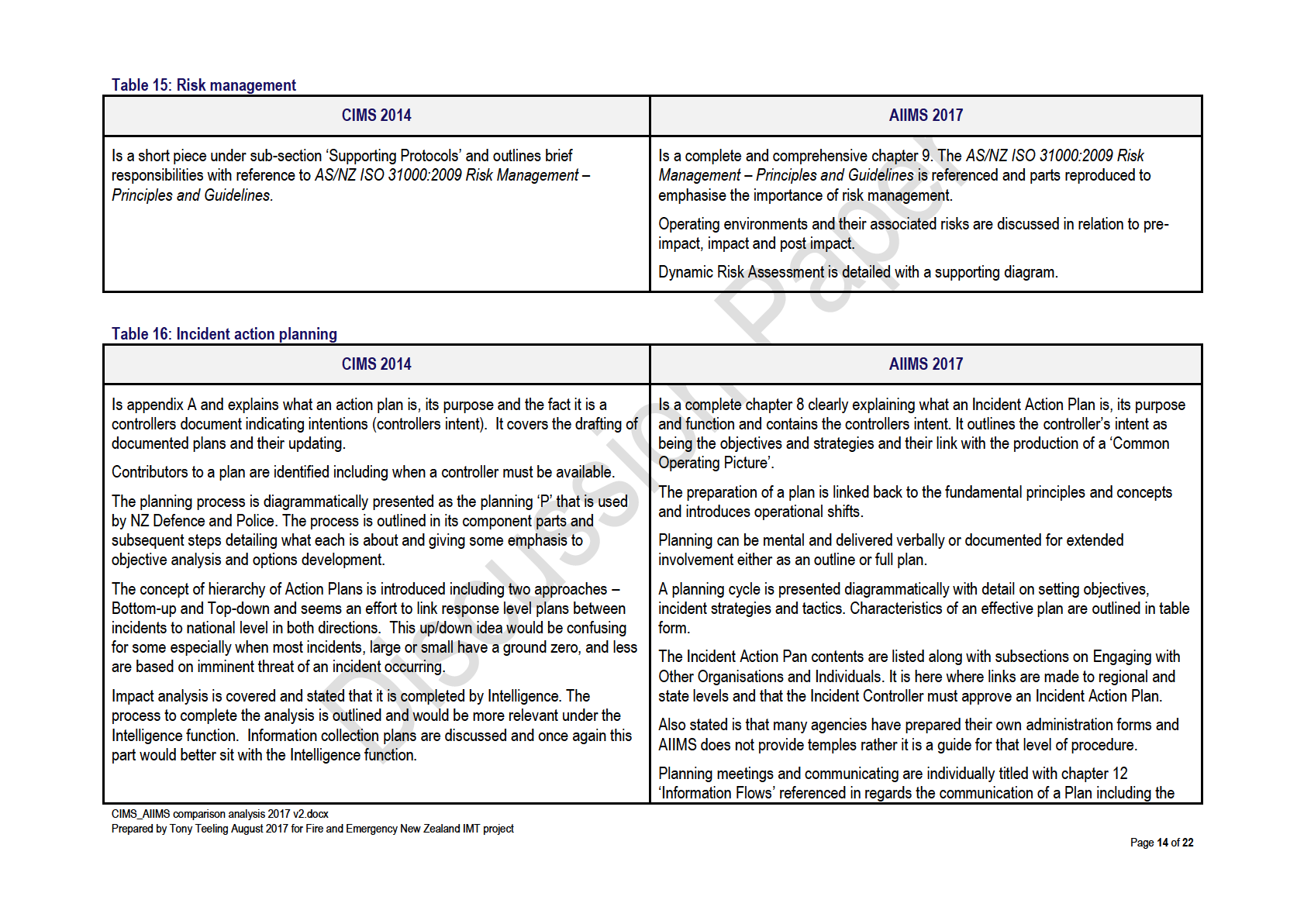
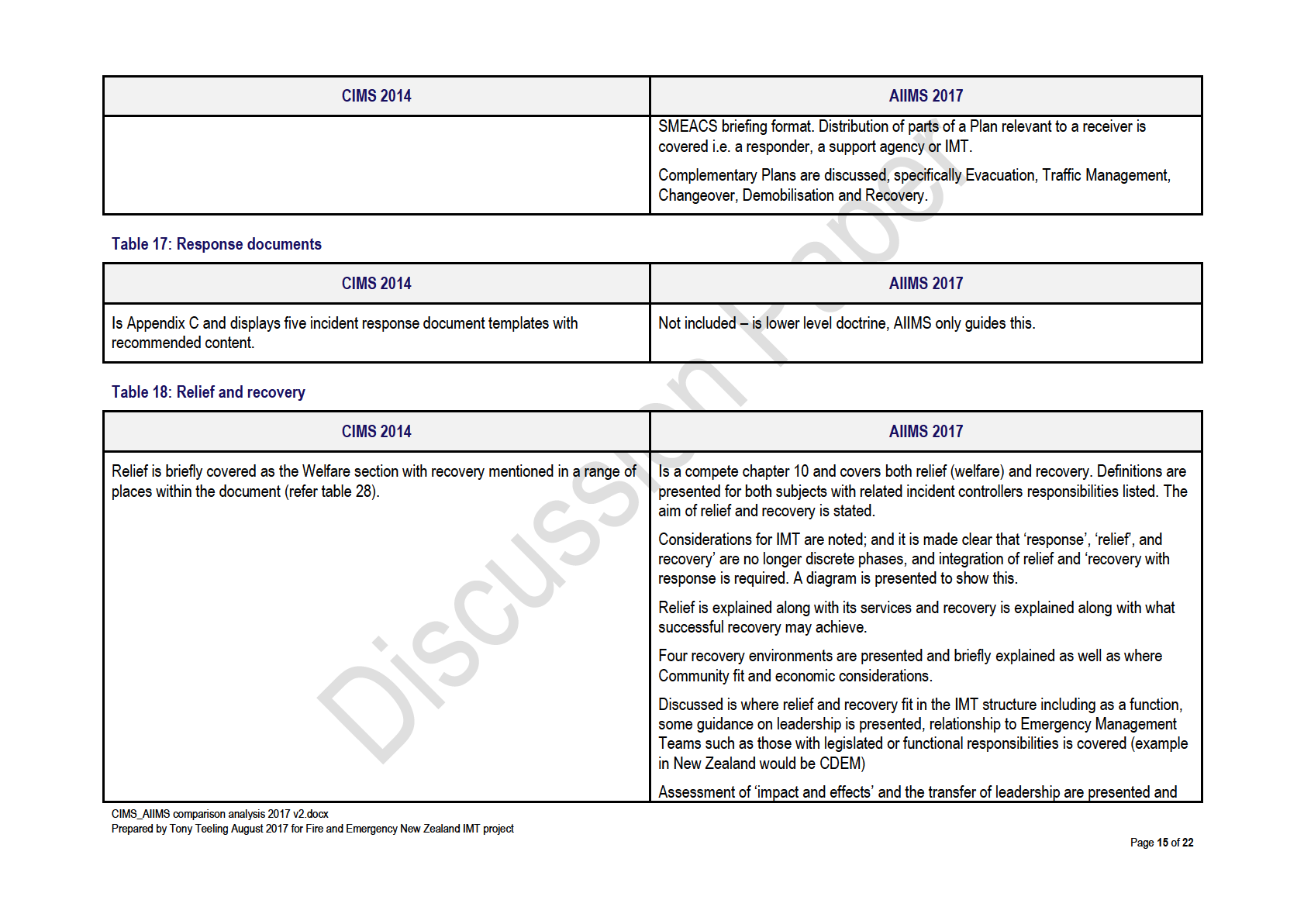
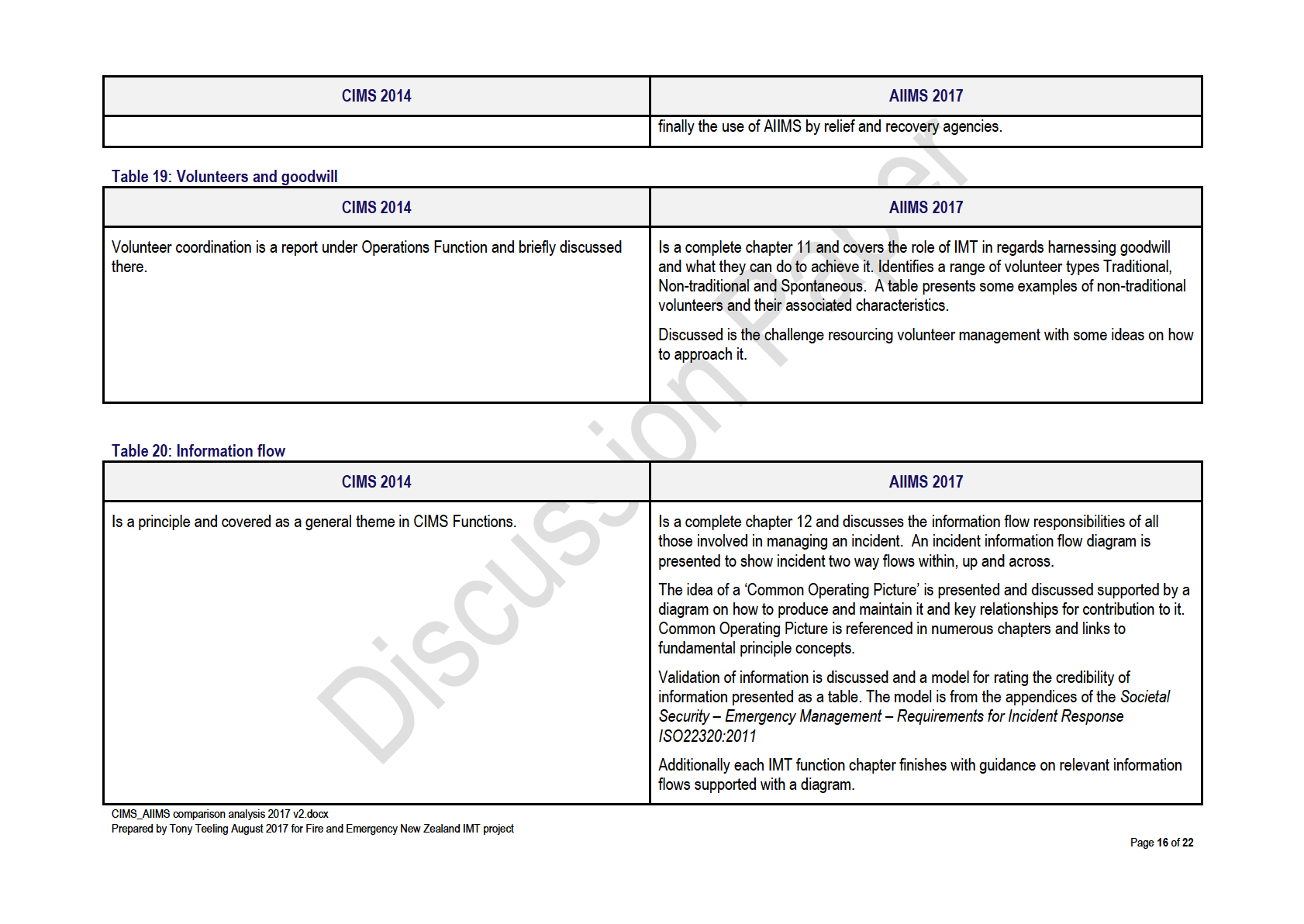
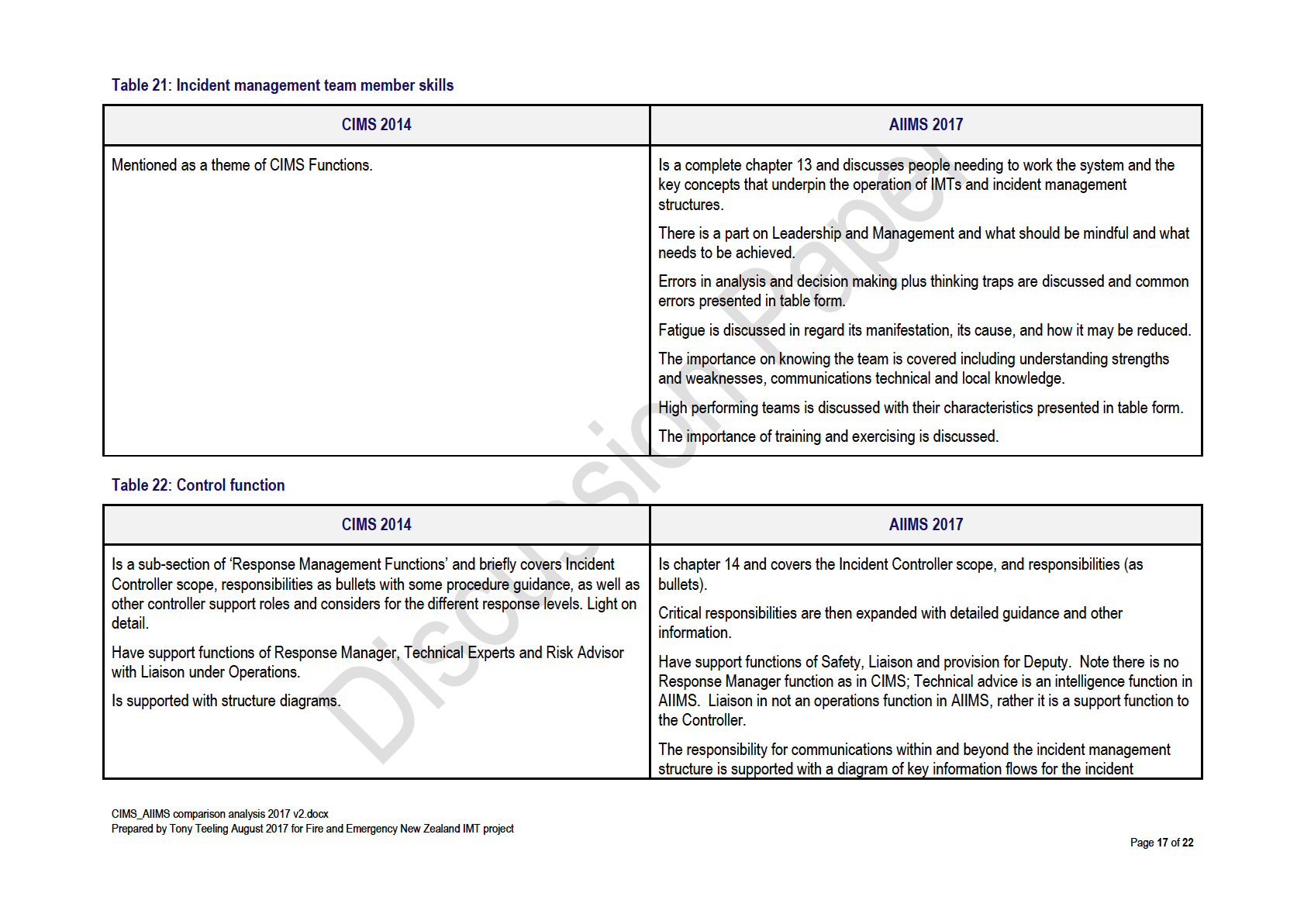
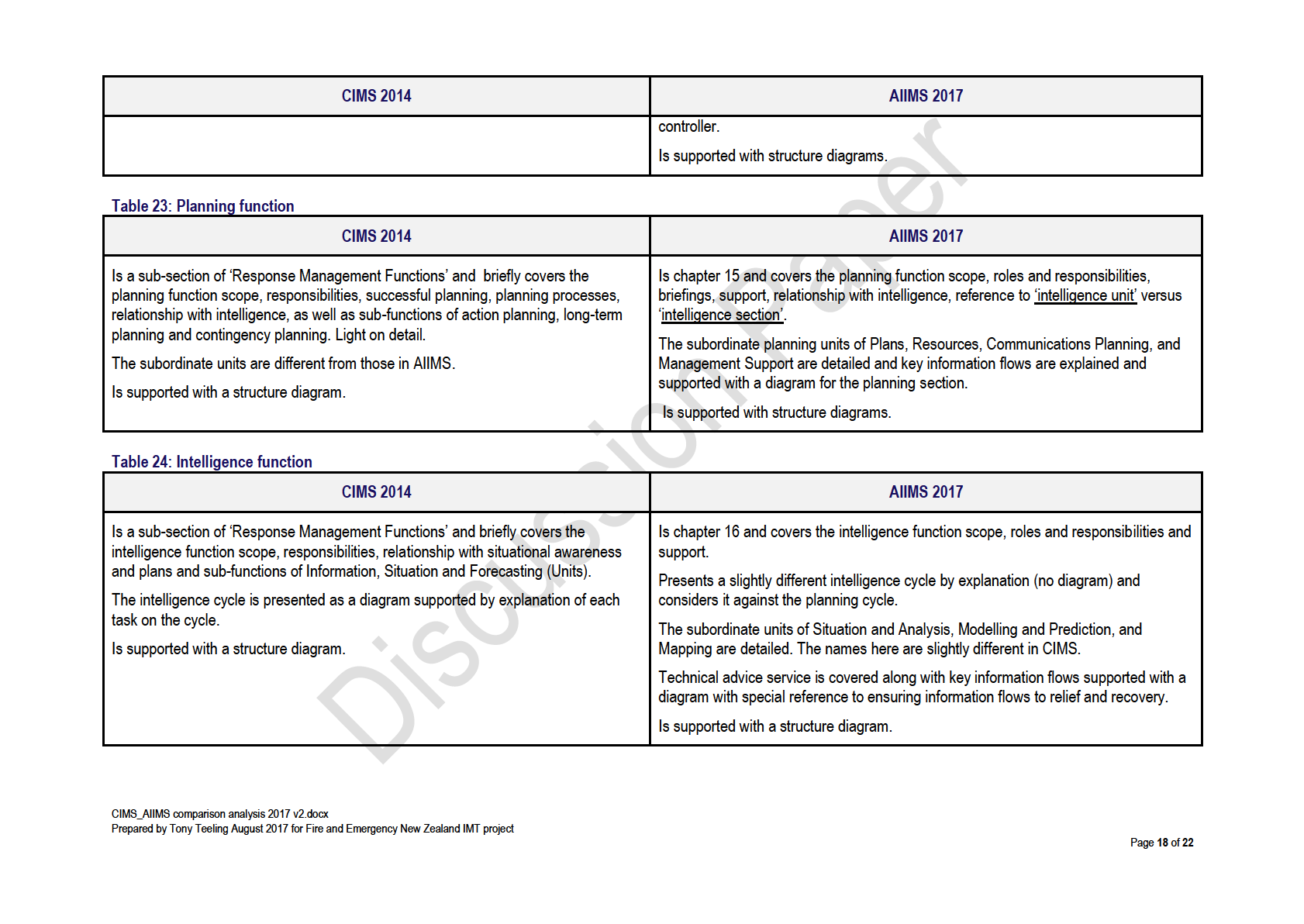
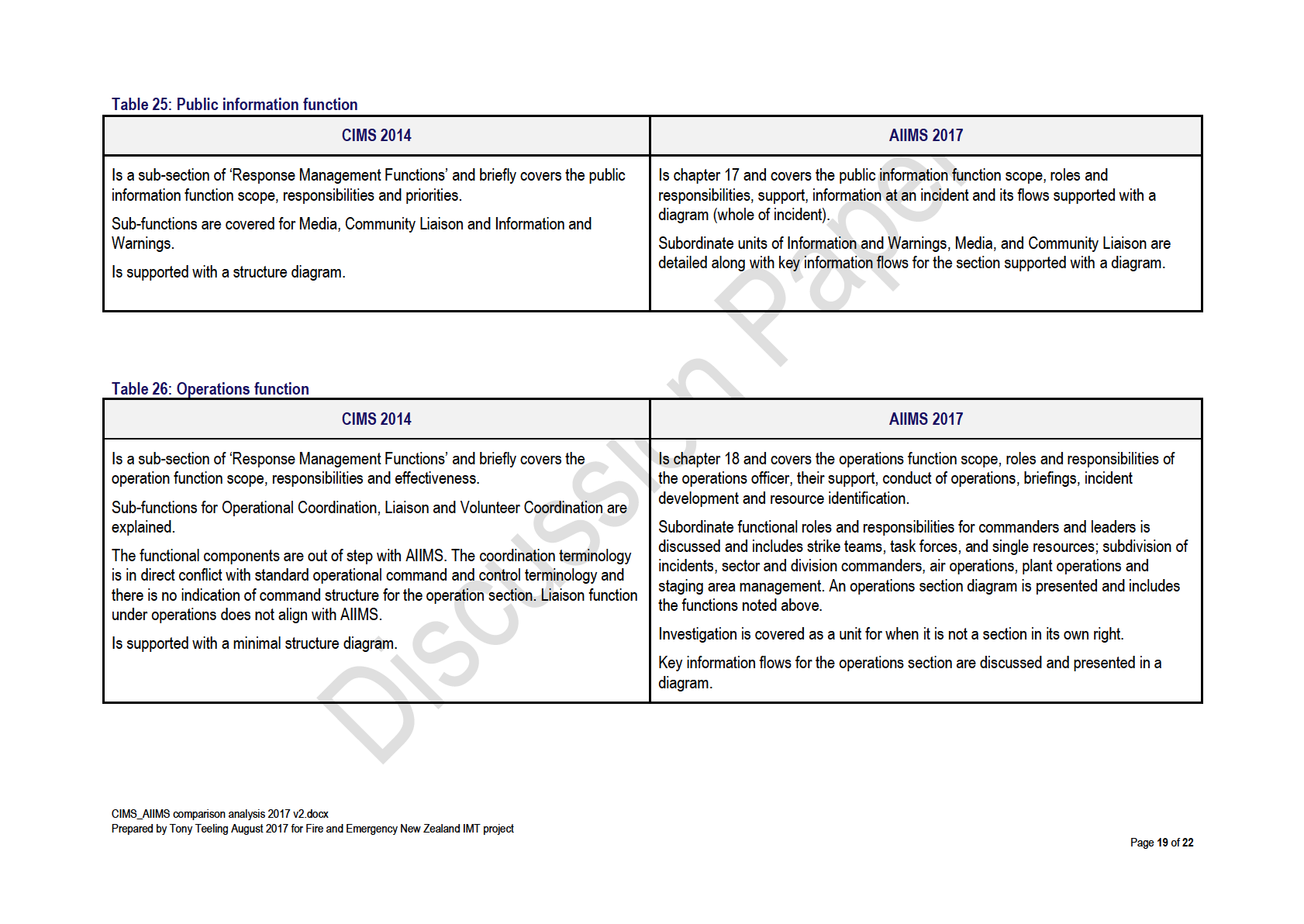
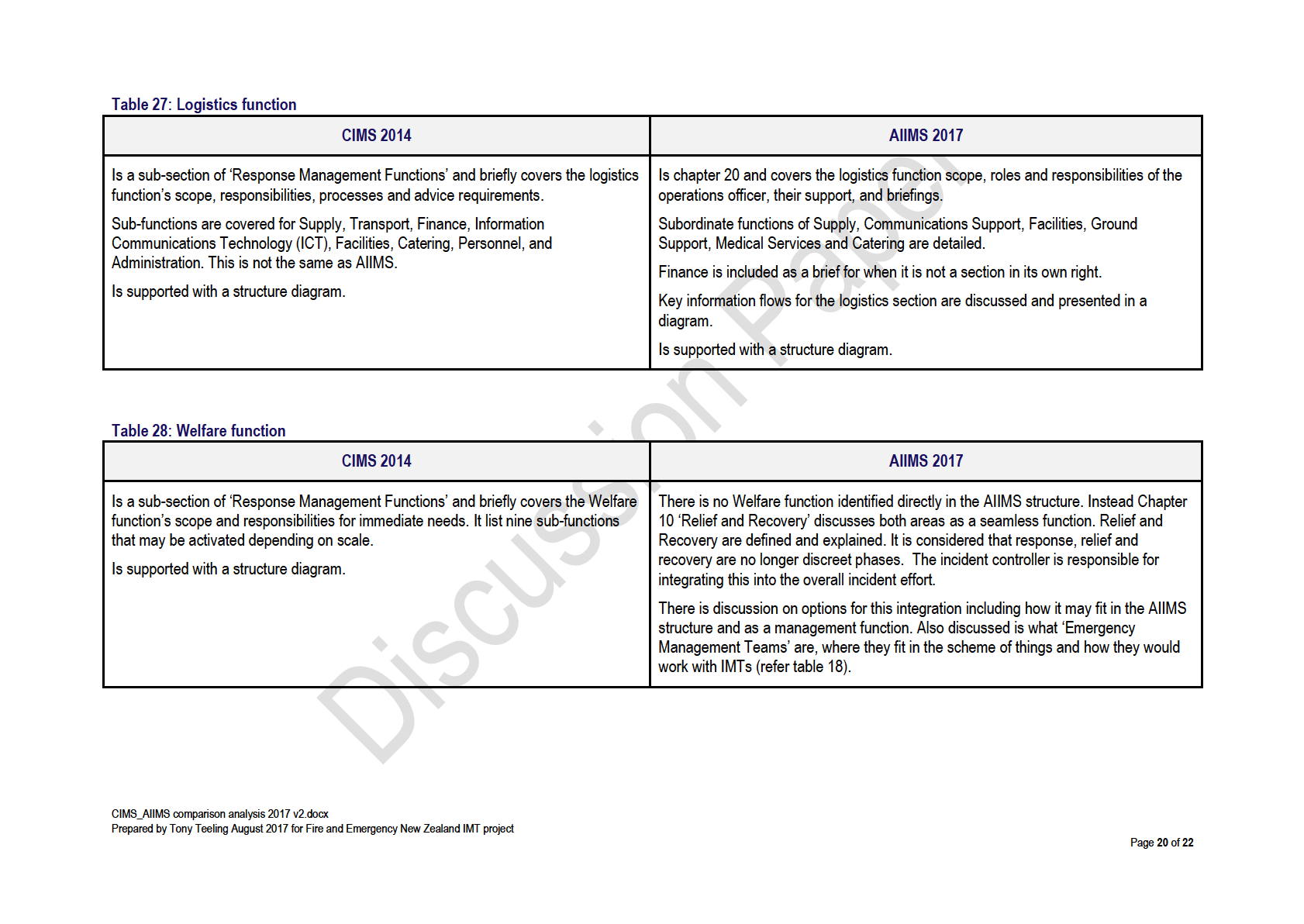
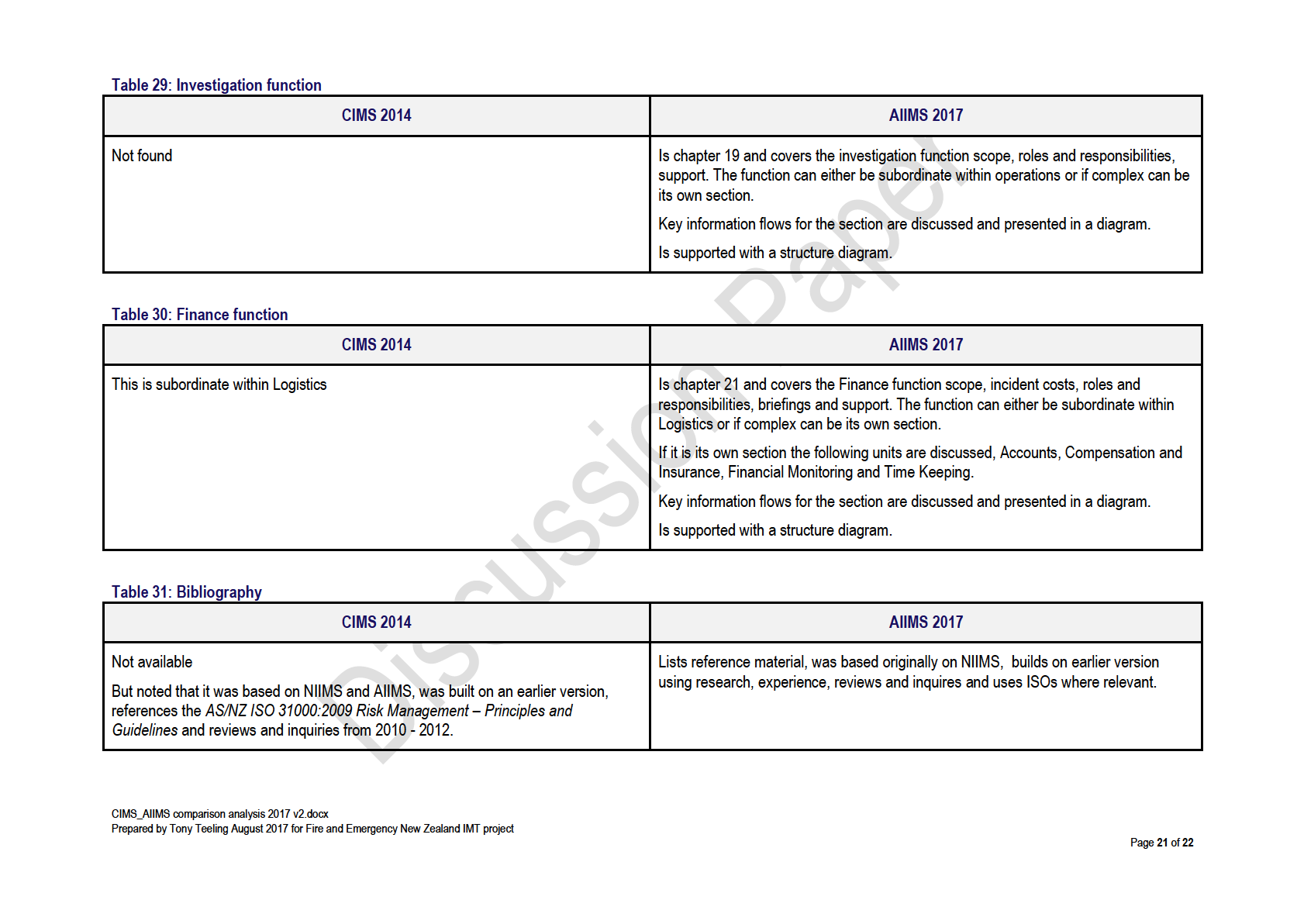
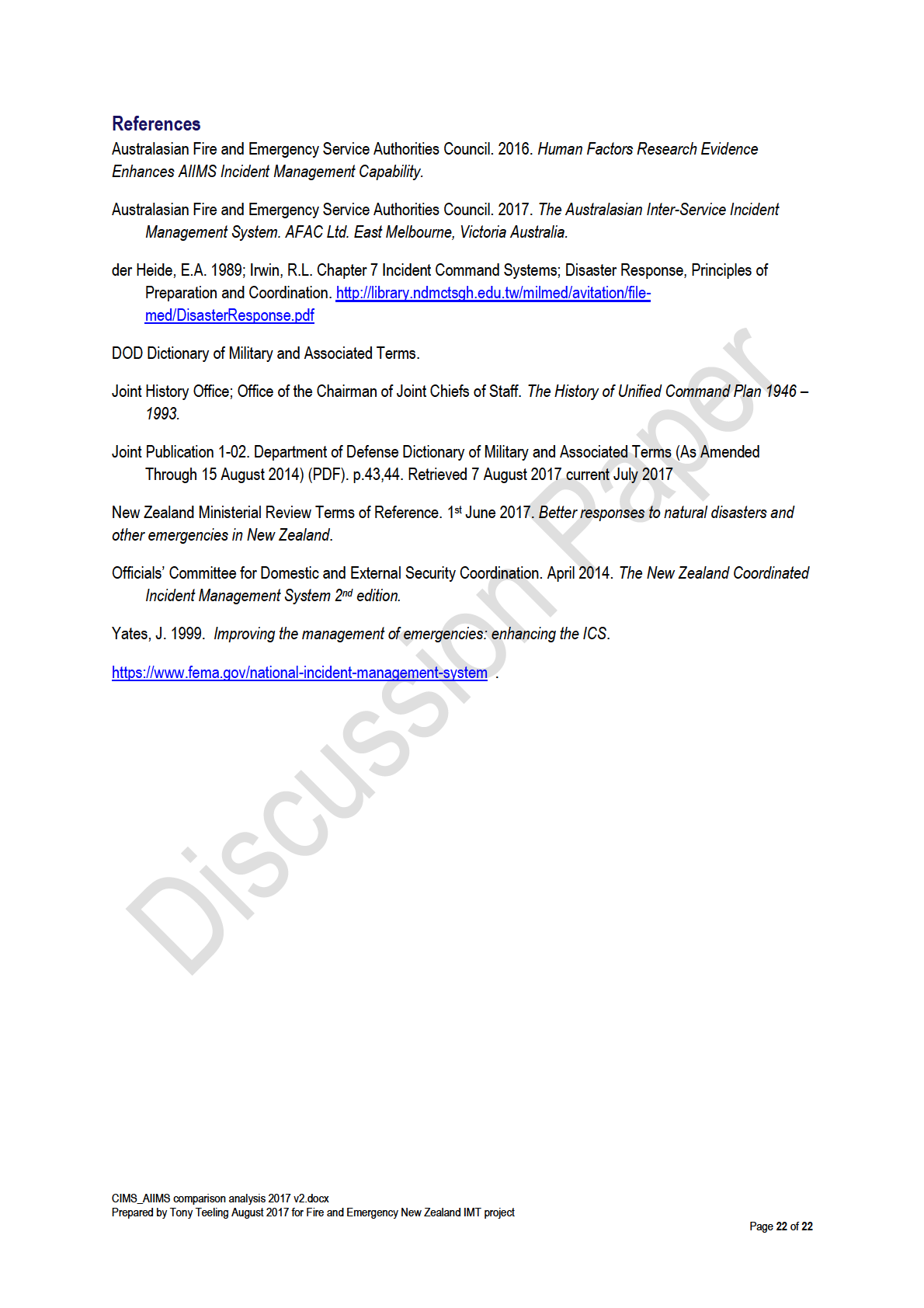


Left blank
CIMS_AI MS dif erences Oct 2017.docx
2
 Purpose
Purpose
To identify the differences between the Coordinated Incident Management System (CIMS) 1st edition 1998, and
2nd edition 2014, and the Australasian Inter-Service Incident Management System (AIIMS) 4th edition 2017, for
briefing and discussion purposes.
Approach
The analysis was completed to identify key system differences in the context of agency adoption,
implementation, and more specifically operational and planning aspects and their relevance to the majority of
incident responses.
Each System’s manual was consulted for detail along with an earlier comparison paper completed in August
2017. Knowledge of incident command systems (ICS) application and anecdotal information were also used.
System references to governmental frameworks and legislative requirements were not included in the analysis.
Application
The paper has been prepared as a reference document for use when discussing or briefing the subject of ICS in
New Zealand. Information is presented in table form as eight themes or topic headings, with information on each
of the three ICS presented, followed by highlighted discussion points and summary support information for quick
reference. The following abbreviations have been made in the analysis section;
1) CIMS 1 – has the meaning CIMS 1st edition 1998
2) CIMS 2 – has the meaning CIMS 2nd edition 2014
3) AIIMS – has the meaning AIIMS 4th edition 2017
Summary
AIIMS and CIMS are both incident command systems. CIMS 1 is very brief but aligns with AIIMS, however CIMS
2 and AIIMS are poles apart in some key areas.
AIIMS is intended for incident level management, including those that are complex, and focusses on incident
management and operational outcomes for that level. It presents guidance in a concise and succinct way for
incident management and functional management requirements.
CIMS 2 tries to incorporate a more encompassing emergency management framework resulting in it being
irrelevant or unusable for the majority of incident responses. There is a distinct disconnect with incident level
management which is manifested in the strong emphasis on coordination with little credence given to command
and control.
CIMS 2 loses the focus on operation outcomes in its quest for effective coordination. Further, its guidance in
regard incident action planning introduces themes of multiple action plans and multiple management levels in a
hierarchal way. This is not the approach needed for the majority of incident responses, and significantly reduces
its relevance for operational personnel.
Prepared by
Date: 10th October 2017
CIMS_AI MS dif erences Oct 2017.docx
3
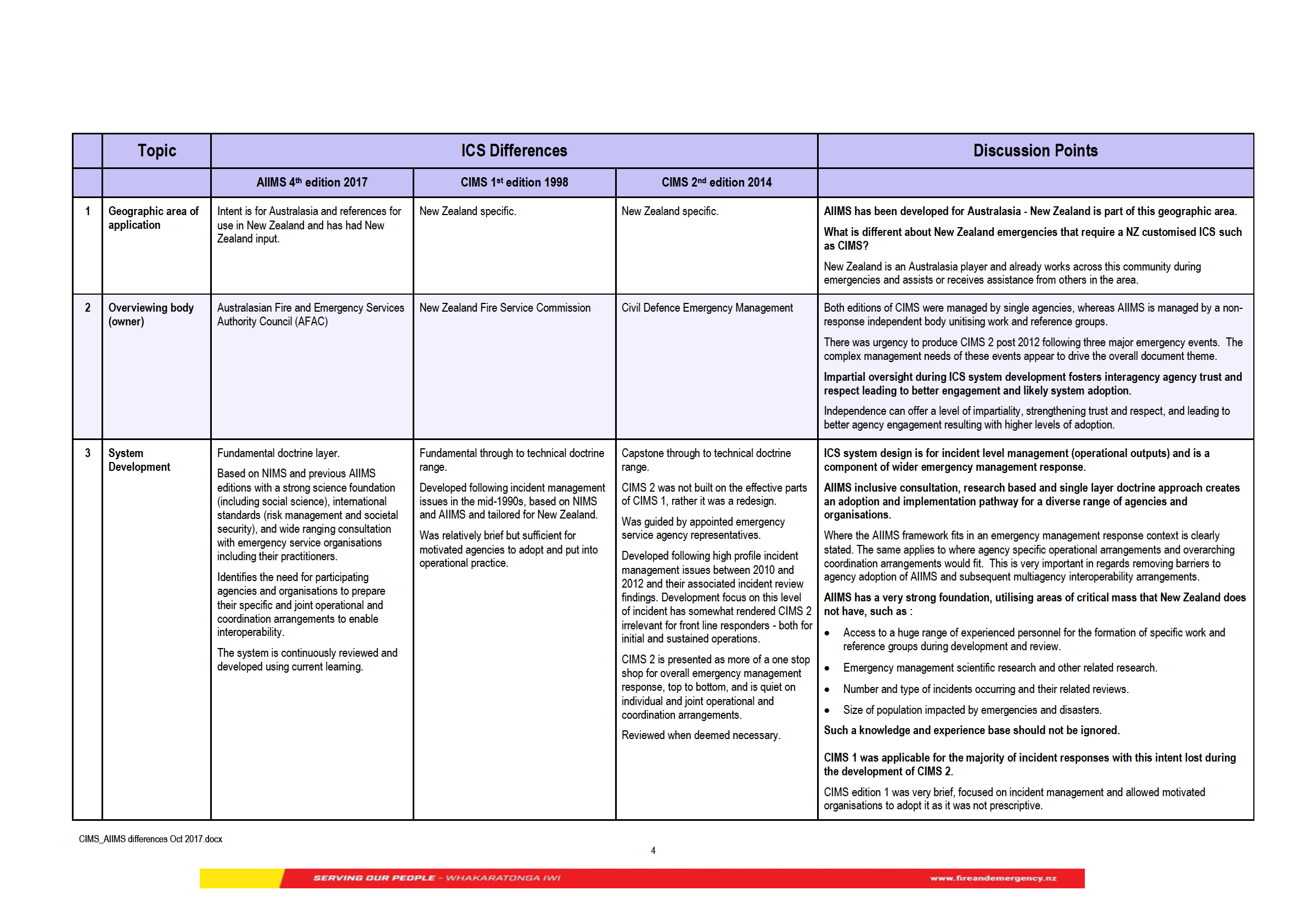

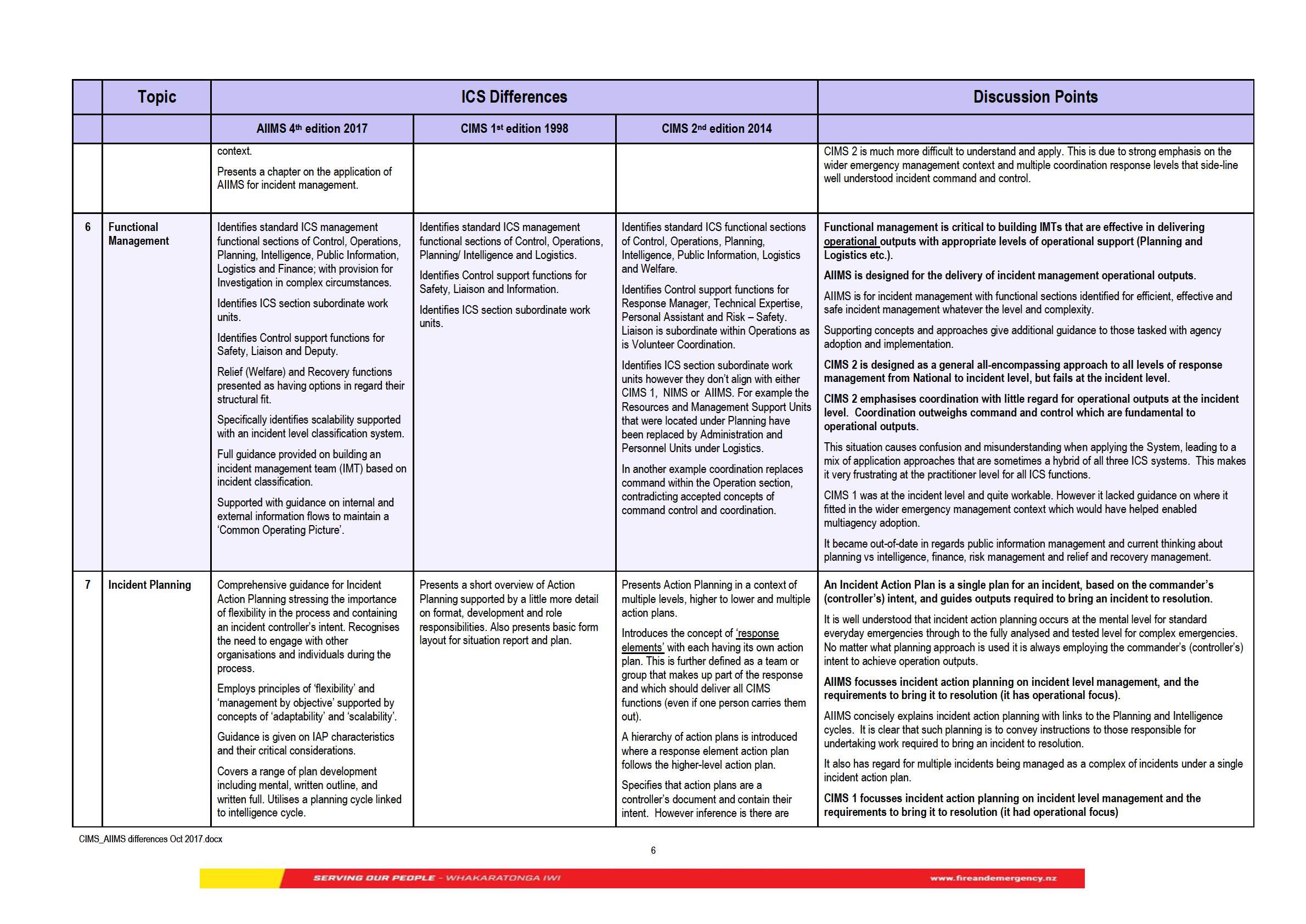
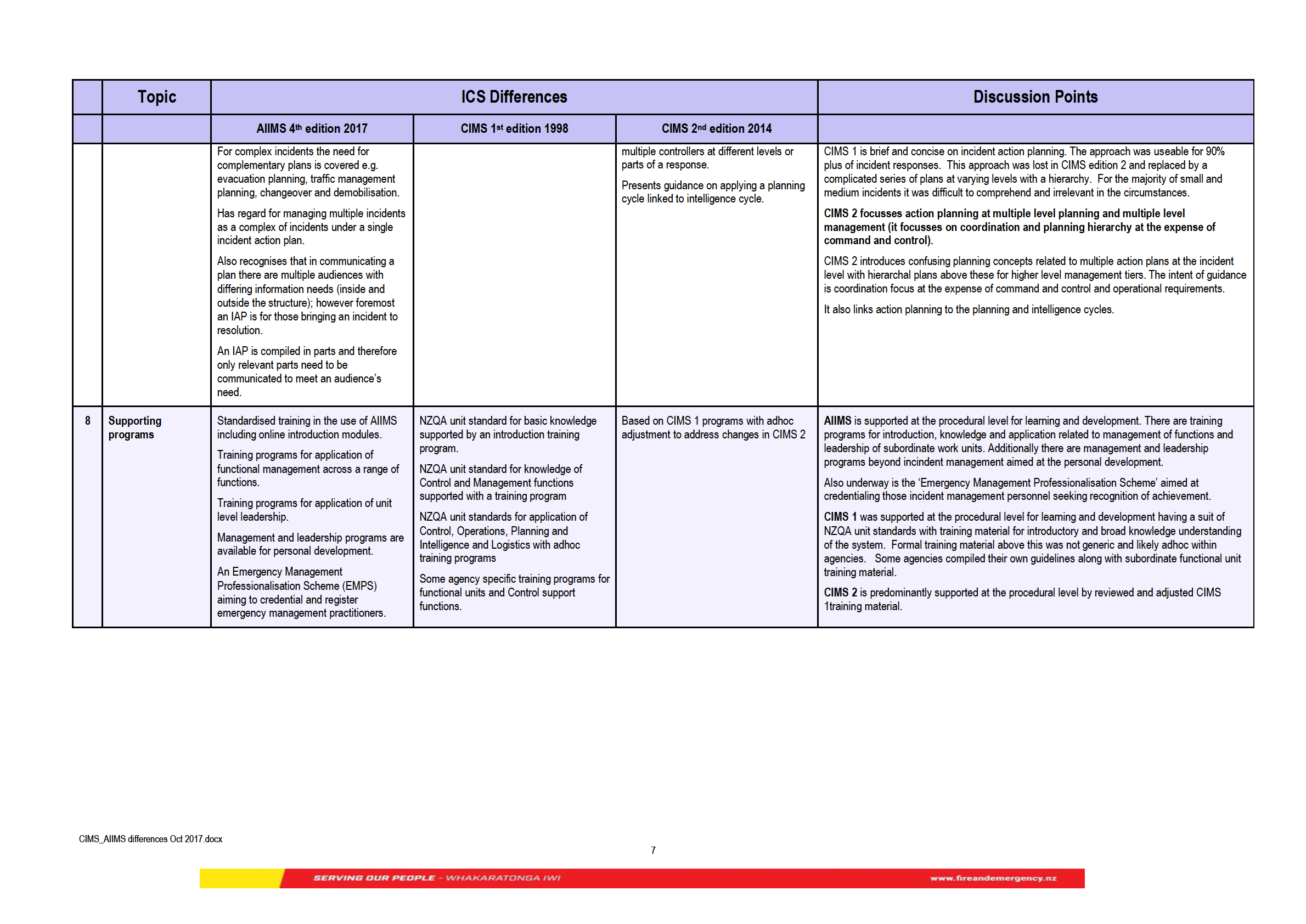
Out of Scope
From: David Hunt [mailto:[email address]]
Sent: Wednesday, 15 November 2017 2:10 PM
To: Rasmussen, John ; Roddan, Anthony
Subject: FW: Incident Management Systems available for use in NZ. July 2017
Hi John and Tony
CFYI
Regards
Dave Hunt
National Advisor Operations (Kaiwhiri Ruruku ā Motu) Operations | Department of Conservation | PO Box 10‐420,
Wellington ‐ 6143| 18‐32 Manners Street, Wellington ‐ 6011
From: David Hunt
Sent: Wednesday, 15 November 2017 7:57 a.m.
To: [email address]
Cc: Bryan Jensen ; Jamie Cowan ; Philip MacDonald ; [email address]
Subject: Incident Management Systems available for use in NZ. July 2017
Good morning Kevin
I recently read the ”Independent Operational Review of the Port Hills fires” and see there is a strong push from the
Review team for FENZ to use AIIMS (Recommendation 1).
1
“Recommendation 1 Fire and Emergency New Zealand adopts a single doctrine, the Australasian Inter‐Service
Incident Management System (AIIMS), for incident management. That the new organisation use this doctrine to
train/exercise and develop people.”
I also note that FENZ has identified in its Action‐Plan‐Summary.pdf on the AFAC Independent Operational Review
Port Hills fires, February 2017 Appendix 1, that it will:
1.3 We will contact other agencies (particularly Civil Defence and Police) to indicate that a move to AIIMS is being
considered.
December 2017
Chief Executive, National Commander Urban and National Manager Rural.
As you are aware, Jamie and I have prepared some material that we sent to you in July (attached and email below)
and that this may be worth revisiting before FENZ starts implementing the Action Plan, especially Action 1.3.
Regards
Dave Hunt
National Advisor Operations (Kaiwhiri Ruruku ā Motu) Operations | Department of Conservation | PO Box 10‐420,
Wellington ‐ 6143| 18‐32 Manners Street, Wellington ‐ 6011
Out of Scope




















 Dalley, Amelia
From:
Dalley, Amelia
From:
Jones, Rhys
Sent:
Tuesday, 3 April 2018 4:45 PM
To:
Howard Broad [DPMC]
Subject:
RE: CIMS/AIIMS
Hi Howard,
Not a simple answer.
FENZ’s position is that we agree that we need one system and that CIMS is the correct approach for NZ due to it
detailing the high level inter‐agency environment … however there are significant operational deficiencies in the
current CIMS that makes it difficult to work at the incident management level. Our suggestion (and our current
lobbying) is to absorb the AIIMS operational processes into the next CIMS update. The advantages of this approach
would be:
AIIMS has a good operational structure that is well tested and integrated across the emergency response
and civil community sectors (but we acknowledge that it is not entirely compatible at the higher level to
NZ’s government and legislative structure)
AIIMS is recognised as the international regional incident management system for the South Pacific and
Australia, so our people would be familiar with AIIMS if we contributed to a multi‐national deployment
We can tap into all the AFAC AIIMS training and accreditation systems
With all of this in mind FENZ and MCDEM are already working on this approach and are committed to bringing the
other agencies together for a discussion about what is the best reform for NZ.
I suggest that during the HRB meeting on Thursday we call for a briefing by the CIMS working group at the June
meeting.
Rhys Jones
Chief Executive
Executive Assistant – Tracey Morgan
– [email address]
National Headquarters, 80 The Terrace, Level 12
PO Box 2133, Wellington 6140
[email address]
www.fireandemergency.nz
From: Howard Broad [DPMC] [mailto:[email address]]
Sent: Tuesday, 3 April 2018 1:49 PM
To: Jones, Rhys <[email address]>
Subject: CIMS/AIIMS
[IN‐CONFIDENCE]
Rhys
1
Can I do a quick check with you before I do anything else? On the subject of agency commitment to CIMS.
As you know some years ago (as far back as 1998 and then reconfirmed at periodic intervals) agencies collectively
went around the buoys on the question of the best inter‐agency incident management doctrine to use. It was
agreed that CIMS would be the approach. Agencies now train for this. In addition there is additional development
led on behalf of HRB conducted by DPMC to firm up unit standards and build CIMS into CDEM controller job
specifications and training. Also as you know it is a recommendation from TAG that CIMS be reinforced by agencies
(I think they had a particular target at local government level but not exclusively) and DPMC has a lead role in
implementing TAG recommendations opr at least offering government policy advice on their recommendations.
As the DPMC work progresses, we find the occasional pocket of people within agencies who hanker for the AIIMS
model – which is Australian based. I sense some of this is found within FENZ.
My question is – what is the extent to which this is a mandated approach by FENZ? I suspect this is just a doctrinal
debate but to the extent that it exists it is worrying the developers working on CIMS.
Therefore, as I say, before I do anything I just thought I would informally tap into your view?
Regards
Howard
The information contained in this email message is for the attention of the intended recipient only and is not necessarily the official view
or communication of the Department of the Prime Minister and Cabinet. If you are not the intended recipient you must not disclose, copy
or distribute this message or the information in it. If you have received this message in error, please destroy the email and notify the
sender immediately.
This email message was encrypted and has been decrypted by
MailMarshal SES
This email message was signed and the signature has been verified by
MailMarshal SES
This e-mail message has been scanned and cleared by
MailMarshal
2

















































